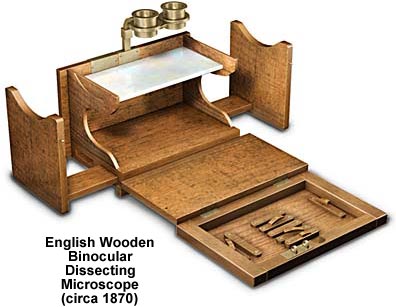Binocular Wooden Dissecting Microscope
This elegant microscope is described as Collin's Lawson Binocular Dissecting Microscope in The Microscope 6th Edition by Jabez Hogg and is also reviewed in Gerard Turner's book The Great Age of the Microscope. The microscope was made for Dr. Henry Lawson, a Professor of Histology at St. Mary's Hospital in London, who was elected a Fellow of the Royal Society in 1868.

Charles Collins, an English instrument designer in London, advertised this microscope in his 1878 Guide to the Purchase of Microscopes. He referred to the oak-framed box microscope as Dr. Lawson's Binocular Dissecting Microscope, which sold for a little over £ 2. The frame opens in the front portion of the box housing to reveal a tray for dissecting instruments. A pair of adjustable sliding hand-rests also protrude from the sides of the box. Housed on a brass rod is a pair of magnifiers on dovetails that allow binocular vision at a short distance. The dissecting stage is made from opal glass. As sold in the late 1870s, the microscope was equipped with a pair of eyepieces, one pair of scissors, two scalpels, four needles, a set of tweezers and an adjustable mirror.
BACK TO NINETEENTH CENTURY MICROSCOPES
